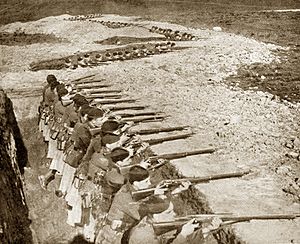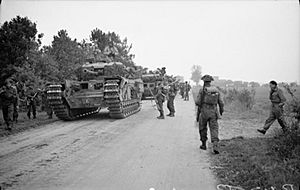Glasgow Highlanders facts for kids
Quick facts for kids Glasgow Highlanders |
|
|---|---|

Cap Badge of the Glasgow Highlanders
|
|
| Active | 1868–1973 |
| Country | |
| Branch | |
| Type | Infantry |
| Role | Line infantry |
| Part of | Lanarkshire Rifle Volunteers 1868–1881 Highland Light Infantry 1881–1959 Royal Highland Fusiliers (Princess Margaret's Own Glasgow and Ayrshire Regiment) 1959–1967 52nd Lowland Volunteers 1967–1973 |
| Garrison/HQ | Greendyke Street, Glasgow |
| Motto(s) | Nemo Me Impune Lacessit (No One Assails Me With Impunity) (Latin) |
| March | Quick – Highland Laddie |
| Engagements | Battle of Modder River Battle of Festubert Battle of Loos Battle of the Somme Battle of Arras Battle of Passchendaele Battle of Normandy Battle of the Scheldt Operation Plunder |
| Insignia | |
| Tartan | MacKenzie Tartan |
The Glasgow Highlanders was a special group of soldiers. They were an infantry regiment in the British Army. They were part of the Territorial Force, which later became the Territorial Army. This group was made up of volunteers.
The regiment became a volunteer part of the Highland Light Infantry in 1881. They fought bravely in both World War I and World War II. In 1959, the Highland Light Infantry joined with another regiment. They formed the Royal Highland Fusiliers. The Glasgow Highlanders later joined the 52nd Lowland Volunteers in 1967.
Contents
History of the Glasgow Highlanders
The Glasgow Highlanders started in 1868. They were first called the 105th Lanarkshire Rifle Volunteers. A group of Highlanders who moved to Glasgow formed them. They were part of the civilian Volunteer Force.
They wore a uniform similar to the Black Watch regiment. This new unit had 12 different groups, called companies. Many experienced volunteers joined them. These volunteers came from other Glasgow units.
The 105th group recruited people from all over Glasgow. For example, one company was from Partick. Another was from Crosshill. One company was even formed by people from Islay. Their main office was in Glasgow.
In 1880, the group was renamed. It became the 10th (Glasgow Highland) Lanarkshire RVC. Later, in 1881, it joined the Highland Light Infantry (HLI). It was then called the 5th (Glasgow Highland) Volunteer Battalion, Highland Light Infantry.
The soldiers in this battalion were special. They continued to wear their traditional kilts. Most of the HLI wore trousers instead. The 5th Battalion always wore the Government tartan. This is also known as the Black Watch tartan. They also had their own unique cap badge.
In 1888, a plan was made for volunteer units. They would gather in brigades if there was a war. These brigades also helped with training. The HLI battalions were part of the Clyde Brigade. This later became the Glasgow Brigade. In 1902, the HLI battalions formed their own group. It was called the 157th (Highland Light Infantry) Brigade.
A cadet group from Blairlodge School joined the battalion from 1891 to 1904. In 1900, the battalion added a cyclist company. Soldiers from different parts of Glasgow joined various companies. For instance, A Company was from Springburn.
The battalion sent soldiers to South Africa. This was during the Second Boer War. They earned their first special honor there. It was for their service at the Battle of Modder River.
The Glasgow Highlanders in World War I
In 1908, the Volunteer Force changed. It became the new Territorial Force (TF). The unit was then called the 9th (Glasgow Highland) Battalion, Highland Light Infantry. They were still part of the Highland Light Infantry Brigade. This brigade was part of the 52nd (Lowland) Division.
During World War I (1914–1918), two more battalions were created. These were based at home. Their job was to send new soldiers to the 1st Battalion in France. The 1st Battalion fought very well. They were part of the 2nd Division. They fought in battles like Festubert and Loos.
In May 1916, the battalion moved to the 33rd Division. They fought in major battles. These included the Somme, Arras, and the Third Battle of Ypres. After the war, the Glasgow Highlanders were disbanded. This happened to many units in the Territorial Force. The story of their bravery was later made into a play. It was called The Big Picnic.
The Glasgow Highlanders in World War II
In 1920, the Territorial Force was restarted. It was now called the Territorial Army. The Glasgow Highlanders formed a single battalion again. In 1935, they moved to a new main office. It was known as Walcheren Barracks.
The 1st Battalion was still part of the 157th Infantry Brigade. This brigade belonged to the 52nd (Lowland) Infantry Division. In 1940, the 1st Battalion went to France. They were part of the Second British Expeditionary Force. Their mission was to help cover the retreat of British soldiers. These soldiers were being evacuated from Dunkirk.
For the next four years, the 1st Battalion trained in the United Kingdom. They learned mountain warfare and airlanding operations. In October 1944, the 52nd Division went to Belgium. They helped capture Walcheren Island. This was during the Battle of the Scheldt.
In 1939, the Territorial Army was ordered to double in size. This was to prepare for the threat of Nazi Germany. So, the 1st Battalion created a second unit. It was called the 2nd Battalion. This new battalion joined the 15th (Scottish) Infantry Division.
The 2nd Battalion stayed in the UK until June 1944. Then, they went to France. They fought in the Battle of Normandy. This included Operation Epsom and the Second Battle of the Odon. They also fought in Operation Bluecoat. Later, they played a small part in Operation Market Garden. They then took part in Operation Veritable. They crossed the Rhine River in Operation Plunder. Finally, they moved into Germany.
During Operation Epsom, the 2nd Battalion suffered many losses. They lost 12 officers. Nearly 200 other soldiers were injured or killed. This was mainly around the village of Cheux. This meant they lost a large part of their fighting force in just one day.
After the Wars
In 1949, the unit was renamed. It became the '1st Battalion, The Glasgow Highlanders, The Highland Light Infantry (City of Glasgow Regiment)'. In 1959, it joined the new Royal Highland Fusiliers Regiment. Its name stayed the same.
In 1967, a new army reserve was formed. It was called the Territorial Army and Volunteer Reserve (TAVR). The battalion officially ended its separate existence. It joined with other battalions. They formed new companies within three new TAVR battalions.
The name "Glasgow Highlanders" continued in some ways. There was an 'HQ (Glasgow Highlanders) Company'. This was part of the 52nd Lowland Volunteers. Also, 'C (Glasgow Highlanders) Company' was part of the Royal Highland Fusiliers. When the latter group was disbanded in 1969, only the 'HQ (Glasgow Highlanders) Company' remained.
In 1973, this company changed its connection. It joined The 'Royal Highland Fusiliers'. This officially ended the Glasgow Highlanders as a separate unit. However, the name continued in a small way. A group of the Army Cadet Force used the name. In 2014, this cadet unit officially changed its name. It became F Platoon RHF (Glasgow Highlanders). This was to keep the historic link alive.
Images for kids





